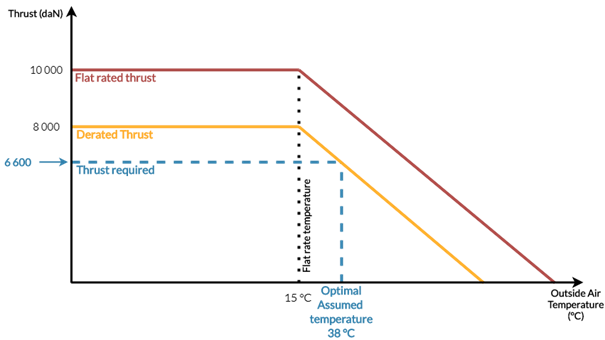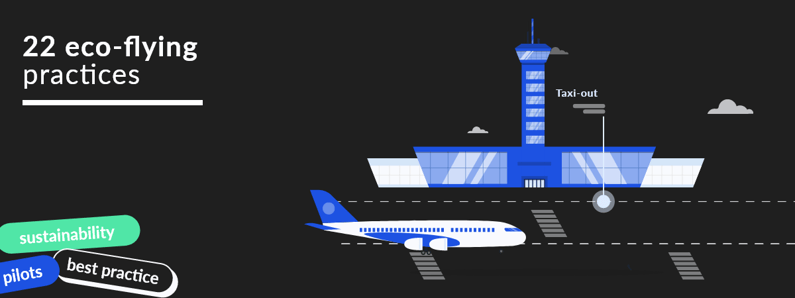What you'll learn:
|
Reduced Thrust Takeoff is also called Derated Takeoff or Flex Takeoff.
The thrust required to take off an aircraft is often less than what may be provided by the engines, called full takeoff thrust, also known as TOGA.
So, we can define a reduced thrust takeoff as a takeoff that uses less thrust than the engines provide.
One of the main reasons to use the minimal thrust required at takeoff is to reduce maintenance costs. Regular reduced thrust takeoff applications yield significant cost savings for an airline.
By decreasing internal engine temperatures and the exhaust gas temperature (EGT) at takeoff, it reduces engine wear resulting in a longer engine on-wing life. Most engine wear will occur at the highest temperatures, and a 1% reduction from full take-off thrust will result in a 10% saving in engine life, as the last few degrees are the most damaging. Therefore, less maintenance is required as the engine may achieve more flight cycles between two maintenance actions.
The cost savings depend on the engine type and several other factors, like labor cost and engine age. However, according to the IATA, using reduced thrust instead of full thrust during takeoff saves about 150 US$ per engine and per takeoff.
A reduced thrust takeoff procedure does not reduce fuel consumption during the flight; on the contrary, it may even increase it. Nonetheless, as engine wear is reduced, the engine remains more efficient longer. It is thus hard to conclude if it saves fuel in the long run.
From an environmental perspective, a reduced thrust takeoff also means fewer emissions.
As most emissions are not linear with thrust settings, a full thrust takeoff emits significantly more nitrogen oxides (NOx), black carbons (BC), hydrocarbons (HC), and carbon monoxide (CO) than a reduced thrust takeoff. For instance, this study showed that reducing thrust at takeoff instead of full thrust may generate fewer NOx emissions down to 47%, and black carbon emissions down to 71%.
These emissions have two undesirable effects:
- First, they contribute to global warming. NOx emissions, for example, are responsible for the formation of ozone, a greenhouse gas.
- They also affect public health, being an important factor in developing respiratory diseases like asthma.
However, it is not clear whether there is a reduction in CO2 emissions. CO2 emissions are proportional to fuel consumption, and as we discussed previously, it is difficult to assess the fuel savings related to reduced thrust takeoff.
There are two different methods to reduce takeoff thrust:
-
The derated takeoff
The derated thrust method consists of reducing the engine's rated thrust to a given level below full thrust. There may be one or more derate levels on an engine. Therefore, the pilot should select one that provides enough thrust to takeoff.
-
The assumed temperature thrust reduction takeoff or Flex takeoff
The assumed temperature method consists of entering a temperature, known as assumed temperature or FLEX temperature (flex temp), in the Flight Management Computer (FMC) and is interpreted as the actual outside air temperature. The thrust is then electronically limited, as an engine may provide flat rated thrust up to a given temperature, then it decreases linearly with the temperature. As a result, the assumed temperature should be higher than the actual outside air temperature to reduce thrust effectively.
Both methods may be used together to provide the optimal thrust required for takeoff.
A quick example of optimal thrust reduction parameters
Let's consider an engine with a flat-rated thrust of 10 000 daN and a single derate level of 8 000 daN.
The thrust required to takeoff is 6 600 daN, and the outside temperature is 20 °C.
To illustrate how to compute optimal derate level and assumed temperature parameters, let’s have a look at the following chart:

The thrust required is below the derated thrust; thus, it is possible to use it to take off. By selecting it, however, the engine still has more power than required to perform the takeoff. Here is where assumed temperature comes into play: as the outside air temperature is below the optimal assumed temperature of 38°C, one may use it to get the optimal thrust.
Hopefully, these performance calculations are computerized and available to the pilot inside their Electronic Flight Bag, and pilots may enter derate level and assumed temperature directly from their tablet.
By applying reduced thrust where conditions allow, you can significantly reduce engine wear, lower fuel burn, and decrease CO₂ emissions without compromising safety. When feasible, It’s a low-effort, high-impact habit.
You've completed the module!
Sources
- Airport emissions reductions from reduced thrust takeoff operations: https://www.sciencedirect.com/science/article/pii/S1361920916302401
- Reduced Thrust, Boeing:
https://www.smartcockpit.com/docs/Reduced_Thrust_Operations.pdf - Getting to grips with aircraft performance, Airbus: https://www.skybrary.aero/bookshelf/books/2263.pdf
- Guidance material and best practices for fuel and environmental management, 5th Edition IATA October 2011
Want to learn more ?
Check out the 22 main techniques for optimizing fuel burn during all phases of flight.




